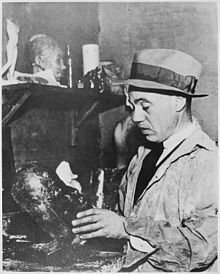| Revision as of 23:35, 22 February 2013 edit142.197.96.56 (talk) →Early life← Previous edit | Revision as of 23:36, 22 February 2013 edit undo142.197.96.56 (talk) →Early lifeNext edit → | ||
| Line 22: | Line 22: | ||
| ==Early life== | ==Early life== | ||
| Sargent Johnson was the third of six children, born to a father of Swedish descent and mother of African American and ] ancestry. They were orphaned at a young age and went to live with their uncle, Sherman Jackson Williams and his wife, May Howard Jackson. May was a famous black sculptress specializing in negro themes and undoubtedly she influenced Sargent Johnson at an early age. In 1915, Sargent Johnson moved to the ] area. The ], which had an influence on the California art movement, took place shortly after his move. The same year, Sargent Johnson married Pearl Lawson and began studying at the A. W. Best School of Art. He attended the ] (now the ]) from 1919 to 1923, where his teachers included the sculptors ] and ]. |
Sargent Johnson was the third of six children, born to a father of Swedish descent and mother of African American and ] ancestry. They were orphaned at a young age and went to live with their uncle, Sherman Jackson Williams and his wife, May Howard Jackson. May was a famous black sculptress specializing in negro themes and undoubtedly she influenced Sargent Johnson at an early age. In 1915, Sargent Johnson moved to the ] area. The ], which had an influence on the California art movement, took place shortly after his move. The same year, Sargent Johnson married Pearl Lawson and began studying at the A. W. Best School of Art. He attended the ] (now the ]) from 1919 to 1923, where his teachers included the sculptors ] and ]. | ||
| ==Career== | ==Career== | ||
Revision as of 23:36, 22 February 2013
| Sargent Claude Johnson | |
|---|---|
 | |
| Born | Sargent Claude Johnson (1888-10-07)October 7, 1888 Boston, Massachusetts |
| Died | October 10, 1967(1967-10-10) (aged 79) San Francisco, California |
| Nationality | American |
| Known for | Painting, sculpture, ceramics |
Sargent Claude Johnson (October 7, 1888 – October 10, 1967) was one of the first African-American artists working in California to achieve a national reputation. He was known for Abstract Figurative and Early Modern styles. He was a painter, potter, ceramist, printmaker, graphic artist, sculptor, and carver. He worked with a variety of media, including ceramic, clay, oil, stone, terra-cotta, watercolor, and wood. He was in the Communist Party for most of his life.
Early life
Sargent Johnson was the third of six children, born to a father of Swedish descent and mother of African American and Cherokee ancestry. They were orphaned at a young age and went to live with their uncle, Sherman Jackson Williams and his wife, May Howard Jackson. May was a famous black sculptress specializing in negro themes and undoubtedly she influenced Sargent Johnson at an early age. In 1915, Sargent Johnson moved to the San Francisco Bay area. The Panama-Pacific International Exposition, which had an influence on the California art movement, took place shortly after his move. The same year, Sargent Johnson married Pearl Lawson and began studying at the A. W. Best School of Art. He attended the California School of Fine Arts (now the San Francisco Art Institute) from 1919 to 1923, where his teachers included the sculptors Beniamino Bufano and Ralph Stackpole.
Career
Sargent Johnson began showing his work with the Harmon Foundation of New York in 1926. Through this distinguished foundation that supported African American art, he exhibited many of his pieces and became locally and then nationally known. He won numerous awards during his time with the Harmon Foundation. In the late 1930s, Sargent Johnson commissioned his work with the Federal Arts Project (FAP). As a member of the bohemian San Francisco Bay community and influenced by the New Negro Movement, Sargent Johnson's early work focused on racial identity. According to Johnson, "Negroes are a colorful race; they call for an art as colorful as they can be made." Beginning in 1945, and continuing through 1965, Sargent Johnson made a number of trips to Oaxaca and Southern Mexico and started incorporating the people and culture, particularly archeology, into his work. Other subjects included African American figures, animals, and Native Americans.
Auction Records
On February 23, 2010, Swann Galleries auctioned Sargent Claude Johnson’s Untitled (Standing Woman), a painted terra cotta sculpture, circa 1933-35, for $52,800 - an auction record at the time for the artist. In 2009 the University of California, Berkeley unwittingly sold a work by Johnson for $164.63, that was later valued at more than a million dollars. The twenty-two foot carved redwood relief panel was eventually purchased by the Huntington Library and will be displayed in its new American wing.
Notes
External links
 Media related to Sargent Claude Johnson at Wikimedia Commons
Media related to Sargent Claude Johnson at Wikimedia Commons- Sargent Johnson in Voices and Images of California Art